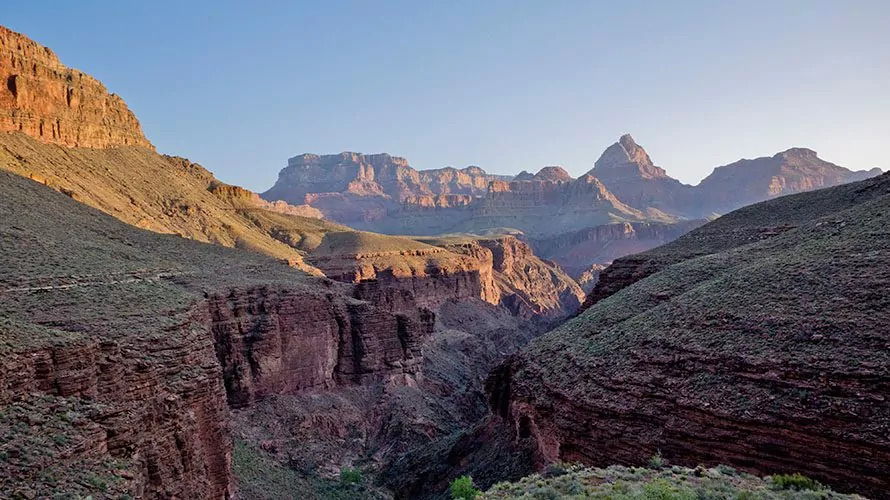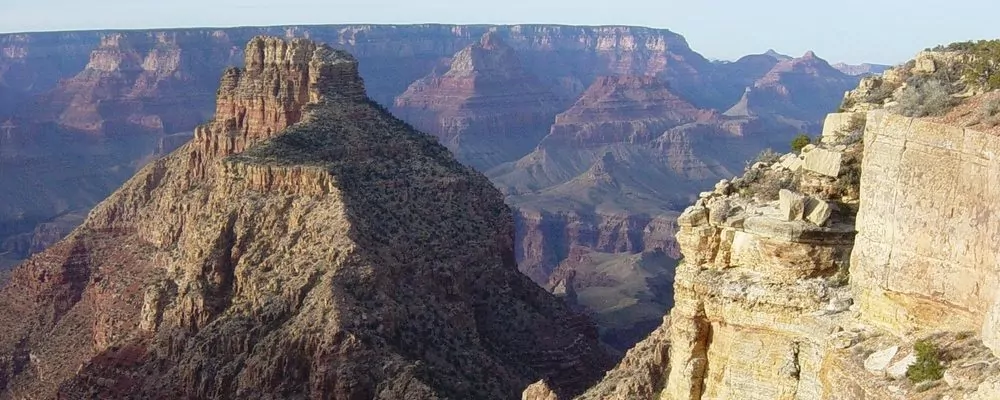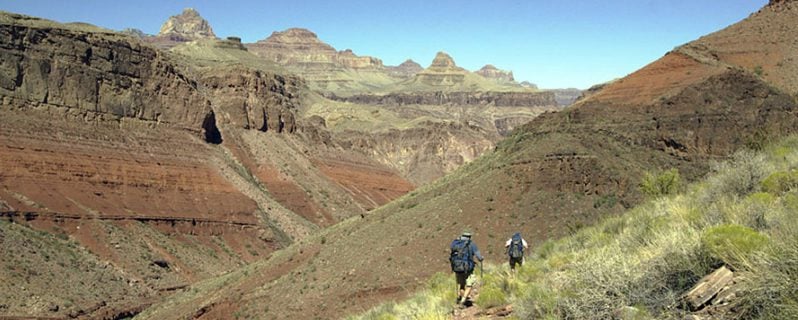
New Hance Trail
General Description
Each trail in the Grand Canyon offers its own challenges, and every rim-to-river trail is a steep descent into the middle of the Earth. But the New Hance Trail is unlike any other, it’s intense grade and rugged route will have you to the river in a mere 6.5 miles. The trail forces hikers to scramble down and over rocks throughout the Kaibab and Toroweap. Once you reach the grassy saddle, you begin to descend on a dry wash through the Supai formation, weaving and wandering in and out of the wash through braided trails. Each of these braids will take hikers to the top of the Redwall, leading you on a challenging traverse for about a mile. Watch for damage from rock slides through this section. The trail continues at a steep descent as you hike the switchbacks of the Redwall and drop to the Tonto, where you will follow the wash to the Colorado River.
The New Hance Trail is in the primitive use area of the National Park, and therefore for experienced Canyon hikers, and even then it will be a good challenge. It is an unmaintained trail, and one of the most difficult on the South Rim. Remember to bring plenty of water, as the only reliable water source is the Colorado River. Any experienced hiker will enjoy the New Hance Trail, and be awarded with some of the best views on the South Rim while getting one heck of a workout. Hikers will love the geology of Red Canyon, providing a colorful look into Earth’s history as the Supergroup layer is revealed.
Explore Grand Canyon with Expert Guides
Getting to the New Hance Trailhead
The New Hance Trailhead is approximately 16 miles from the junction of Desert View Drive and South Entrance Road. There are two places hikers can park; the first pullout after Buggln picnic area on the south side of the road, or Moran Point. If you park at the pullout after the Buggln picnic area, you will walk east on Desert View Drive, and if you park at Moran Point, you will walk west to the trailhead. As you walk down Desert View Drive from where you parked, there will be a “No Parking” sign on the north side (Canyon side) of the road, this marks the quarter-mile path that will take you through the pinyon pines and junipers to the trailhead.
History of the New Hance Trail
“Captain” John Hance was the first European American to settle in the Grand Canyon in 1883. He originally built his trails for mining purposes, but later realized that the real money was made in the tourism industry. With his quick wit, exaggerated stories, tall tales and spontaneous personality, he became a hit with tourists. One account recalls an encounter John Hance had with a tourist: “You must understand,” Hance warned the tourist, “that when you get to the bottom of the canyon and reach the shore of the Colorado River it is very warm. You can’t imagine how hot it is. Why, I’ll give my word, I’ve been down there when it was so hot it melted the wings off the flies.” “But, how do the tourists stand it?” the tourist asked. To which Hance smartly replied, “Madame, I have never yet seen a tourist with wings!”
The first trail he built, the “Old Hance Trail”, as it is known today, began just past Grandview Point at the start of Hance Creek drainage. This first trail was prone to flooding and washouts, so he created the “New Hance Trail” down Red Canyon. Red Canyon gives hikers a glimpse into the past, the Supergroup is millions of years of Earth’s history, and the last traces of the “Great Unconformity”- the gap in time from the Tapeats Sandstone and the Vishnu Schist.

The Best Day Hike on the New Hance Trail
Day hiking is a great option if you don’t have a long time in the park, or want to experience a little bit of everything. Day hiking on the New Hance Trail is a great way to see the Grand Canyon, because in a short amount of time and distance, the canyon opens up, revealing expansive and panoramic views of the Grand Canyon and especially layers of rock that are not visible from many other trails. Don’t forget your trekking poles, even for shorter hike, for this trail is knee-aching.
Below are the primary options for day hiking the New Hance Trail:
| Destination | Miles (roundtrip) | Elev | Difficulty | Style | |
| Red Canyon Overlook | 4 mi | 1,982 ft | Moderate | Out and Back |
1. Red Canyon Overlook
Red Canyon is one of the most geologically unique areas in Grand Canyon, it’s crimson red is vibrant and impressive. This short day hike takes you to the top of the Redwall, allowing you to look down on Red Canyon. New Hance trail begins with an overgrown Kaibab limestone, and makes it’s way down a rocky hillside to the Coronado Butte saddle. Over the course of the next mile, you will drop more than 1,000 feet. Cairns mark the trail where rock slides have made navigation difficult. The trail leads to the top of the Redwall, and continues east, traversing the ledge until reaching the top of a sandstone pinnacle, where Red Canyon comes into view for the first time. This is a great spot for a lunch, allowing you to soak in the views. Once ready to return to the south rim, begin hiking up the same way you came down.
Maximize Your Visit to Grand Canyon National Park on a Hiking Tour
Guided day hike tours and multi-day packages allow visitors the opportunity to make the most of their time in Grand Canyon National Park and to do it hassle-free. Guided tours include gear (backpack, trekking poles, crampons in winter), meals, accommodations on multi-day tours, local transportation, and a professional Grand Canyon hiking guide. Through their knowledge, stories, and personal passion, guides can bring a place to life in a way that’s much more difficult to do on your own. Read more about Grand Canyon Hiking Tours.
Award Winning USA Hiking Vacations

2 New Hance Backpacking Trips
Backpacking down the New Hance is not for the faint-of-heart. Your knees will be aching, your legs shaking, your heart thumping, but the payoff is well worth all of it. If you want an adventure with little to no crowd, a true experience of the Grand Canyon, and sights unlike any other, the New Hance is the trail for you.
| Route | Miles (roundtrip) | Difficulty | Campgrounds | |
| Hance Rapid | 13 mi | Strenuous | Red Canyon Use Area (BD9) | |
| New Hance to Grandview | 23 mi | Strenuous | Red Canyon Use Area (BD9) Hance Creek Use Area (BE9) or Horseshoe Mesa Use Area (BF5) |
1. Hance Rapid (2 days)
It’s only 6.5 miles down to the Colorado River from the New Hance trailhead, but that does not mean that it is an easy accomplishment. The trail is steep and loose, and rock slides have obscured the trail in many sections. Route finding skills are essential through the Supai. Once on the Redwall, the grade appears to be gentle from above, however, there are only few switchbacks, making the trail just as steep and exposed as the sections above. Soon though, the trail reaches the bottom of Red Canyon. You will follow this dried creek bed to the find your solace at the Colorado River. A feat not to be taken lightly. This is Use Area BD9, use an established campsite, and make yourself at home for the night. Wake early the next morning, and begin your treacherous climb back to the south rim.
2. New Hance to Grandview (3-4 days)
This trip is a shuttled loop, it is best to park one car at the trailhead of New Hance and one at Grandview, where you will end the trip. The trip can be done New Hance to Grandview, or vice versa.
Descend down the New Hance to Hance Rapid, as described above. Make camp in Use Area BD9 at the river. On the second morning, hike up the dried creek bed a couple yards to a large sand dune, where the Tonto Trail begins westward, marked by some cairns. You will wind in and out of side canyons on the Tonto, while blooming agaves tower above you. After around 7 miles, the Tonto will meet up with the Grandview trail, where Use Area BE9 is available for camping. Or, you can continue up Grandview Trail toward Horseshoe Mesa, and make camp there for the night. The last morning, wake early and hike out the Grandview Trail.
Join a Guided Grand Canyon Backpacking Trip
Joining a Grand Canyon backpacking tour is a worry-free, adventurous way to experience the Grand Canyon. With your gear, meals, local transportation, permits, and fees taken care of for you, you can travel light and focus 100% on enjoying the hiking experience, while the guide company takes care of everything else. Also, by going with local experts you’ll enjoy a greater level of safety and gain a much better understanding of the history and ecology of this remarkable region. Read more about a guided Grand Canyon backpacking trips.
All-inclusive Grand Canyon Backpacking Adventures

When to Hike and Seasonal Considerations
Grand Canyon gets hot, super hot, in the summer, so just take that into consideration when planning your trip. Check the weather forecast for Grand Canyon before starting any hike.
Necessary Permits
Day Hike Permit
Grand Canyon National Park does not require permits for day hikes.
Backpacking Permits
Visitors are required to obtain a backcountry permit if they are planning on camping anywhere besides established campgrounds on the rim of the canyon. Permits are easy enough to get in the off season, but during busy times of the year, they may be harder to obtain, and many trails are on a lottery system, meaning you may or may not get the trip you want. For more information on Grand Canyon’s permit system, click here.
Suggested Packing List
Day Hike Packing List
- 3-6 liters of water (more in summer)
- broken-in boots
- Salty, calorie-rich snacks
- lunch
- backpack
- trekking poles
- crampons (in winter)
- wide-brimmed hat
- sunscreen, sunglasses
- non-cotton t-shirt
- rain jacket
- warm non-cotton layer
- 1st-aid kit
Backpacking Packing List
- all items listed for day hikes PLUS
- multi-day backpack
- 3-season tent
- sleeping bag
- sleeping pad
- headlamp
- map
- backpacking stove and fuel
- backpacking meals
- 3 pairs wool socks
Please Respect Our National Parks – Leave No Trace
We strongly recommend abiding by all Leave No Trace ethics guidelines and practices so that our national parks and public lands are preserved for the enjoyment of future generations and for the people and animals who call these places home. Simple things like packing out your trash, obeying national park rules, and respecting the peace and quiet of our national park trails is a great start. If you’re going on a backpacking trip, you can read about more about the 7 Leave No Trace Principles.




